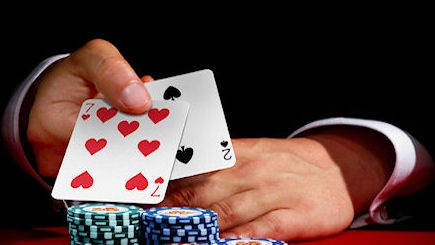This article first appeared in the Jul/Aug 2013 issue of World Gaming magazine.
Debate has long raged about showing your hole cards to your opponents when you’re not required to. To show or not to show? That is the question.

I have said it time and time again – your actions on a poker table should always be made to your advantage. Let’s firstly get a few things straight. Poker is all about winning money. You gauge your success in the game of poker by the amount of money you win or lose. You are not at a poker table to make friends. That is not to say you won’t make friends but that is a by-product and should never be your primary focus if you want to play your best.
Having said that, you don’t want to set out to make enemies and you should always abide by the rules and etiquette that exist to protect players and the game’s integrity. The best way to describe it is in sporting terms. In the world of sport you often hear champions say they play even harder against their friends. I am telling you this because showing your cards at the poker table can often be regarded as arrogant – particularly if you have just managed to pull off an outrageous bluff! Some players are adamant that you shouldn’t do anything to provoke a reaction out of your opponents but I don’t abide by this school of thought. As long as it is done with decorum, revealing your hole cards can be a useful tool to put your opponents off their game.
If you were given just two options: always showing your cards or never showing your cards, then you would certainly choose never to show your cards. The argument here is very simple. Why would you show your opponents how you play different hands? Showing your cards is a lot like bluffing – it is something that you should only do on rare occasions and only when you have a specific reason for doing so such as trying to put a fiery opponent on tilt. I would also suggest players new to poker learn how to play the game well before they start worrying about the art of psychological warfare against their opponents. If you try to play games with a player more experienced than you, chances are you are only going to lose money.
One thing that makes me laugh at a poker table is when I see inexperienced players going out of their way to make their opponents feel better. Why would you want to make your opponent feel good? Let’s look at an example of this. Let’s say you have slow played middle set on the flop in late position. The pot is heads-up and after calling a bet on the flop and the turn, you re-raise on the river. Your opponent contemplates the action for some time before eventually folding and showing top pair with an ace kicker. What he is doing here is trying to encourage you to show him the winning hand. He may even ask you to show him. If you turn over your hand then you will help him feel great about his good fold. He can sit back knowing he made the right decision and that he is on top of his game.

Not showing your hand is a much better option. I guarantee that your opponent will be distracted for the next few hands while he wonders whether or not he was correct to fold! If he is a weak player he might even try to target you in the future, which is exactly what you want.
Even if you are playing against friends or players who show you their cards, don’t fall into this mistake. Throw your cards to the dealer and keep your composure. This is not an easy thing to do but it’s a skill you need to learn. If asked, just say you never show your cards. This is a perfectly acceptable thing to say and you might even gain their respect in the process.
So when should you show your opponents your cards? The short answer to this question is not very often. If you feel confident in never showing your cards, great. If this suits your poker style then stick to it. Also, remember that when you show your cards you are not only showing them to your opponent, you are also giving insight and help to everyone at the table. My own style is more aggressive and confrontational so here are a few examples that may call for showing cards.
- I am in the big blind in a tournament. A player in late position raises to steal my blinds. I instantly push all-in and after some deliberation my opponent folds. I turn over a weak hand to show my opponents on my right that they should stop trying to steal my blinds unless they have a very strong hand.
- It is late in a tournament, I have a big stack and I am looking to steal the blinds as often as possible. I am dealt a big hand, put in a standard raise and everyone folds. I might then table my big hand and say something like, “I keep getting these big cards but no callers”. What you are trying to do here is make your opponents think you always have big cards so they can only call you when they have big cards themselves.
- You are playing against a very aggressive player and you manage to bluff him out of a pot. You think that by getting under his skin you can cause him to go on tilt. You show your cards at the end of the hand specifically to annoy this player. Some players might consider this bad etiquette but I don’t agree. It would be if you did it all the time and if you did it in an unbecoming manner, but you will find this is a tactic you can use to great effect against an aggressive poker player. And to be honest, this is probably a tactic this opponent would use against you if they had the chance!
Who shows first?
One of the big procedural issues in poker is who has to show their cards first at showdown. A showdown means there is no more betting and the two or more players still in the hand are required to table their cards to determine the winner. Online this isn’t a problem because the cards are displayed automatically but in live poker it can be more problematic. If there is betting on the river then the player who makes the last raise is required to show their cards first. If the river action was a simple bet and call, with no raising, then it is the initial bettor who must show his cards first. But what if there is no betting on the river? Then it’s a bit more confusing.
Most of the time the player closest to the dealer button (starting with the player immediately left of the button and moving around the table clockwise) must table their cards first. This is standard in all US poker rooms. In some poker rooms (especially in Australia) it is the last aggressor who is required to show their cards. This means the person who made the last bet or raise (irrespective of what betting street that was on) would be required to table his cards rather than the person who called. This is my preferred option. In Macau it’s a bit trickier because the rules vary from room to room. At Grand Lisboa the rule was always the person to the left of the button showed first, however when PokerStars began hosting tournaments it changed to the last aggressor. The last aggressor rule prevails at City of Dreams where PokerStars have launched their new permanent poker room. Conversely, Venetian, Wynn and StarWorld use the left of the button rule. So you can understand why this issue can be quite confusing!
Some experienced players try to entice newer players to turn over their cards first so the experienced player can get away with not showing their losing hand. This is one of my pet hates at a poker table and it should be up to the dealer to enforce the showdown order rule diligently. My advice is to learn the rules and stick to them. If you have to show your cards first then do it quickly. If it is up to your opponent to show his cards first then stand your ground and insist that the correct order is adhered to. If other players are trying to bully you or the dealer isn’t doing their job properly then call over the poker room manager and insist that the rules are enforced. This is your right, not merely a privilege.







